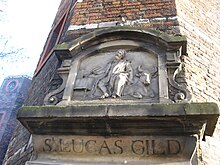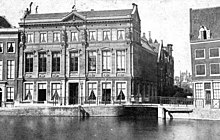Arti et Amicitiae
The Sociëtait Arti et Amicitiae (lat .: arts and friends) has played a key role in the Dutch and in particular in the Amsterdam art scene - also known as Arti for short. It was founded in 1839 and is still a hub for artists and those interested in art in the metropolis of Amsterdam .
History and structure

After the last artists' guild was dissolved in Delft in the Netherlands in 1791 , thought was given for a long time to re-establishing an effective substitute association, similar to the model from bygone days.
In 1839 the Sociëtait Arti et Amicitiae was founded. A year later, the “Grand Salon Dupond” building, located at Rokin 3 in the center of Amsterdam, was acquired from the auction . It was to become the home of this young society. The declared aim was to appeal to the distinguished public and to gain their interest in art. At first it was called Arti et Amicitiae - Sociëtait - Sociétë des Beux Arts on Rokin 3. Today it is called Maatschaapij Arti et Amicitiae, in the vernacular for short Arti. Today the house is assigned the number 112.
In 1841 the new exhibition room was created on the first floor according to the plans of the master builder Marinus Geradur Tétar van Elven, who was also professor and director of the architecture department at the Royal Academy of Fine Arts in Amsterdam.
In order to socially enhance this cooperative of fine arts, the then King William II was offered honorary membership in 1841.
The evenings, also called viewing art, were of great importance. Art lovers and collectors gathered around the artist, who in turn showed pictures and lithographs. The declared aim was to arouse interest in art in order to finally improve the artist's economic situation. This, too, was exemplary and far ahead of its time. A widow and orphan fund was created for their own artists. This was financed from part of the entrance fees, the distribution of the exhibition catalogs and the membership fees of the honorary members. In addition, sales were gradually made from the historical gallery's fund.
Arti et Amicitiae - the opposite pole
Triggered by Napoleon, the art scene was operated and determined by the sovereigns. So gave z. For example, at the Delft Art Academy, non-artists set the stage for art policy. - In the ranks of the society the aim was to create an effective counter-movement. The goal has always been the sovereignty of society, which has been persistently maintained to this day - it was and is still valid, especially from a financial as well as an art-political point of view. In order to increase its popularity, an advertising campaign for a statue for a very important son of the city - Rembrandt van Rijn was launched . One of the founding members of Arti et Amiticae, Louis Royer , created this statue and in 1852 it was bought by King William III. revealed.
One of the main concerns was the creation of a historical gallery with 103 works from scenes from national history.
The increase in storeys that took place in 1841 was interesting because a glass roof let daylight into the elongated exhibition room. In terms of the building structure, this was possible in the roof area because the relatively new steel structure enabled the ribbon of windows to run between the foot and middle purlins. The shading effect was achieved via an internal cantilever cornice. The vertical exhibition areas were divided by pilasters.
Above all, the individually oriented exhibitions by artists from the membership as well as by non-members such as u. a. by Marc Chagall , Vincent van Gogh and Max Liebermann .
Today the society has around 550 artists and 1,100 sponsors as members.
The very valuable and extensive historical library that has been built up throughout the history of this association has been given to the Van Gogh Museum in Amsterdam. The historical archive will continue to be maintained in-house.
Buildings
The premises at Rokin 3 have been retained to this day.
The semi-detached house is characterized by the built-in cast iron supports. The glass roof ensures uniform lighting. The neo-classical facade was accentuated by the four allegories of building, sculpture, engraving and painting - they stand for the art forms combined in the house. These sculptures go back to Franz Stracké. In addition, in the gable there is the hand as a symbol and the ox, patron saint of the former St. Lucas artists' guild. The builder Hendrikus Petrus Berlage excels for the interior. Exhibition rooms, meeting rooms and a private club room have been created here.
The first renovation took place in 1893/94. The main entrance was relocated to the Spui and the stairwell and hallway were renewed. The builders Berlage and Beys, both members of this artists' association, were responsible for this construction project. In the years 1962 - 1964 the building was completely restored and modernized. The main entrance has been moved back to the Rokin. The exhibition rooms have been modernized. The valuable woodwork of the interior and the furniture are still largely intact. In 2009 the neighboring building No. 114 was acquired in order to integrate new premises.
In the valuable staircase there is a gallery of the most famous painters in the Netherlands. These are names like Lizzy Ansingh , George Hendrik Breitner , Marius Bauer , Bernd Blommers , the brothers Jacob Maris , Willem Maris and Matthijs Maris , Isaac Israëls , Jozef Israëls , Lourens Alma Tadema , Hendrik Willem Mesdag , Jan Sluijters , Jan Toorop , Johan Hendrik Weissenbruch , Willem Witsen , Coba Ritsema and Kees Marks .
Willink van Collenprijs
In 1878, the patron Wilhelm Ferdinand Willink van Collen had ordered in his will to transfer an amount of 30,000 guilders to the Sociëteit Arti et Amicitiae as a fund, with the condition that a prize would be given to young Dutch artists during their studies. From 1880 the Willink van Collenprijs was awarded with interruptions until 1950. Initially, it was based on the tiered pricing of the Paris Salon and after the new regulations from 1890 only a 1st prize was awarded, which was awarded several times in 1897, 1909 and 1910 and 1917. The fact that this idea of promoting artists fell on fertile ground in Amsterdam shows both its long duration and the success and level of awareness of a number of award winners up to the present day.
Prize of the Sociëtait Arti et Amicitiae
In addition to the aforementioned sponsorship prize, the Sociëtait also awarded its own prize for artists, which was also very popular. In addition to the annual art exhibitions and the Willink van Collenprijs, these were the only opportunities for the young artists to make their names and their art known.
Important artists as members in the 19th century
- Maria Elisabeth Georgina Ansingh (1875-1959)
- Bernadus Apps (1865–1938)
- Elisabeth Adriani-Hovy (1873–1957)
- Bernardus Antonie van Beek (1875–1941)
- Franciscus Hermanus Bach (1865–1956)
- Constantia Arnolda Balwé (1863–1954)
- Ludolph Berkemeier (1864–1931)
- Cornelius de Brain (1870-1940)
- George Hendrik Breitner (1857-1923)
- Jacobus Ludvicus Cornet (1815–1882)
- Carel Dake (1857-1918)
- Franz Deutmann (1867-1915)
- Jan Dunselmann (1863-1931)
- Adrians Eversen (1818-1897)
- Arnold Marc Gorter (1866–1933)
- Salomon Graf (1873-1943)
- Johannes Hubertus Grégorie (1887–1960)
- Petrus Franciscus Greive (1811–1872)
- Sophie Jacoba Wilhelmina Grothe (1852–1926)
- Hendrik Johannes Havermann (1857–1928)
- Bartholomeus Johannes van Hove (1790–1880)
- Johannes Frederik Hulk (1829-1911)
- John Frederik Hulk (1855-1913)
- Kaspar Karsen (1810-1896)
- Johannes Hermanus Barend Koekkoek (1840–1912)
- Klaas Koster (1885–1969)
- Marinus van der Maarel (1857–1921)
- Willem Carl Nakken (1835-1926)
- Marie van Regteren Altena (1868-1958)
- Sue Roberteson (1855-1922)
- Louis Royer (1793–1868)
- Geraldine van de Sande Bakhuyzen (1827–1895)
- Willy Sluiter (1873-1949)
- Loin Schulman (1851-1943)
- Johann Georg Schwartze (1814–1874)
- Pauline Suij (1863-1949)
- Jacoba Surie (1879-1970)
- Dorotha Arnoldine von Weiler (1864–1956)
- Betsy Westendorp-Osieck (1880–1968)
- Jan Hillebrand Wijsmuller (1855–1925)
- Ernst Witkamp (1854-1897)
- Willem Witsen (1860-1923)
- Else Woutersen van Doesburgh (1875–1957)
Membership artists as award winners
- Ernst Witkamp - took 2nd place in the Willink van Collenprijs in 1881.
- Ernst Witkamp - took 1st place in the Willink van Collenprijs in 1882.
- Jan Hillebrand Wijsmuller - took 1st place in the Willink van Collenprijs in 1883.
- Willem Witsen - took 2nd place in the Willink van Collenprijs in 1885.
- Else Woutersen van Doesburgh - took 1st place in the Willink van Collenprijs in 1910
Non-members as award winners
- Eduard Frankfort - received a gold medal of the Sociëteit in 1905 as a non-member.
swell
- Een vereeniging van ernstige kunstenaars: 150 jaar maatschappij Arti et Amicitiae, 1839–1989, self-published, ISBN 90-6868-026-9
- Monnickendam, M; Röling, J .; Sluyters, Rueter, G., ao - Arti et Amicitiae (1939): Premie-Uitgave tgvh 100 jarig bestaan der maatschappij Arti et Amicitiae 1839-1939, Amsterdam. 1939
Web links
Remarks
- ↑ In 1382 the first artists 'association was founded in Delft, which was later renamed the St. Lucas artists' guild . By 1610 they had been founded in almost every major city in Holland. This was possible because after the Reformation and the shaking off of Spanish Catholic rule, a new regulation could take place in the Lower Lands.
- ↑ At that time it was the aim of these locally organized guilds to protect the economic interests of their artists.
- ↑ The re-establishment of the St. Lucas artists' cooperative in Amsterdam in 1880 had nothing in common with the establishment and orientation of the Old Guilds. Rather, it was a meeting place, a place for further education and a meeting point for art lovers and collectors. However, it could not compete with the Sociëteit Arti et Amicitiae in the long run because it was too academic. Then there was the problem of the lack of exhibition space.
- ↑ This type of print was becoming very popular at the time.
- ↑ In 1820 the Baron Isidore de Taylor set up a project called " Voyages pittoresques et romantiques dans l'ancienne France ". The subject was the depiction of historical monuments, Gothic ruins and wild landscapes as a lithograph , which turned out to be very successful.
- ↑ After the artists' guild had disappeared as an economic instrument to secure the existence and the support from the ruling class had been lost, this form of art support was the best alternative.
- ↑ These were paintings acquired at low prices, donations and things acquired from bequests.
- ↑ This vertical, pillar-like form element in architecture was popular at that time.
- ↑ Van Collen (1847–1878) was a painter and, like his wife Anna van Bosse, an art lover.
- ↑ The French salon provided for five levels: admission to the exhibition combined with the possibility of gold medal, silver medal commendation and mention.
- ↑ There was also the traveling exhibition of living artists , which was also very popular with both artists and visitors. However, it took place every two or three years.
- ↑ a b c d e She belonged to the Amsterdamse Joffers .






